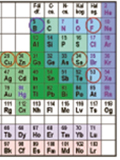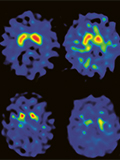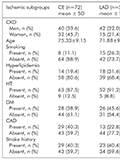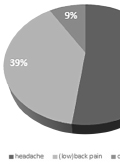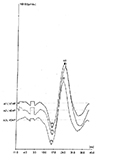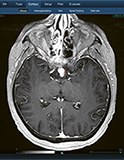The eLitMed.hu medical portal uses computer cookies for convenient operation. Detailed information can be found in the Cookie-policy.
Clinical Neuroscience - 2019;72(11-12)
Content
[Tracing trace elements in mental functions]
[Trace elements are found in the living organism in small (trace) amounts and are mainly essential for living functions. Essential trace elements are in humans the chromium (Cr), cobalt (Co), copper (Cu), fluorine (F), iodine (I), iron (Fe), manganese (Mn), molybdenum (Mo), selenium (Se), zinc (Zn), and questionably the boron (B) and vanadium (V). According to the biopsychosocial concept, mental functions have biological underpinnings, therefore the impairment of certain neurochemical processes due to shortage of trace elements may have mental consequences. Scientific investigations indicate the putative role of trace element deficiency in psychiatric disorders such in depression (Zn, Cr, Se, Fe, Co, I), premenstrual dysphoria (Cr), schizophrenia (Zn, Se), cognitive deterioration/dementia (B, Zn, Fe, Mn, Co, V), mental retardation (I, Mo, Cu), binge-eating (Cr), autism (Zn, Mn, Cu, Co) and attention deficit hyperactivity disorder (Fe). At the same time, the excess quantity (chronic exposure, genetic error) of certain trace elements (Cu, Mn, Co, Cr, Fe, V) can also lead to mental disturbances (depression, anxiety, psychosis, cognitive dysfunction, insomnia). Lithium (Li), being efficacious in the treatment of bipolar mood disorder, is not declared officially as a trace element. Due to nutrition (drinking water, food) the serum Li level is about a thousand times less than that used in therapy. However, Li level in the red cells is lower as the membrane sodium-Li countertransport results in a Li efflux. Nevertheless, the possibility that Li is a trace element has emerged as studies indicate its potential efficacy in such a low concentration, since certain geographic regions show an inverse correlation between the Li level of drinking water and the suicide rate in that area. ]
[The applicability of 123I-FP-CIT SPECT dopamine transporter imaging in clinical practice]
[The 123I-FP-CIT dopamine transporter SPECT imaging is a sensitive method to assess functional dopaminergic neuron terminals in the striatum. The method has also been available in Hungary for years. There are two main indications: (i) to help differentiate essential tremor from clinically uncertain Parkinsonism, including patients with early symptoms and (ii) to help differentiate dementia with Lewy bodies from Alzheimer’s disease. The aim of this paper is to review 123I-FP-CIT SPECT imaging based on international data/guidelines and our own experiences, thereby assisting nuclear medicine practitioners and neurologists.]
Risk factors for ischemic stroke and stroke subtypes in patients with chronic kidney disease
Background - The aim of this study was to compare ischemic stroke subtypes with the effects of risk factors, the relationship between grades of kidney disease and the severity of stroke subtypes. Methods - The current study was designed retrospectively and performed with data of patients who were hospitalised due to ischemic stroke. We included 198 subjects who were diagnosed with ischemic stroke of Grade 3 and above with chronic kidney disease. Results - In our study were reported advanced age, coronary artery disease, moderate kidney disease as the most frequent risk factors for cardioembolic etiology. Hypertension, hyperlipidemia, smoking and alcohol consumption were the most frequent risk factors for large-artery disease. Female sex and anaemia were the most frequent risk factors for small-vessel disease. Dialysis and severe kidney disease were the most frequent risk factors in unknown etiologies, while male sex, diabetes mellitus, prior stroke and mild kidney disease were the most frequent risk factors for other etiologies. National Institute of Health Stroke Scale (NIHSS) scores were lower for small-vessel disease compared with other etiologies. This relation was statistically significant (p=0.002). Conclusion - In order to improve the prognosis in ischemic stroke with chronic kidney disease, the risk factors have to be recognised and the treatment options must be modified according to those risk factors.
The effect of psychiatric comorbidities and stress-coping strategies on perceived quality of life in migraine
Purpose – Migraine is one of the most disabling primary headache conditions. We aimed to detect hidden symptoms of anxiety and depression and to survey stress-coping mechanisms and related quality of life in a large migraine population without any known psychiatric comorbidity. Method – 123 migraine patients (MG) and 66 healthy subjects (HC) completed the Beck Depression Inventory-II (BDI-II), the State and Trait Anxiety Inventory (S-STAI and T-STAI), the Stress and Coping Inventory (SCI) and the 36-Item Short Form Health Survey (SF-36). Results – MG patients reached significantly higher scores on the BDI-II and the T-STAI yielding previously undetected anxiety and depression symptoms. Significant differences were present on the SCI: higher stress scores and lower coping levels suggested impaired stress-coping strategies in migraine. MG patients achieved significantly lower scores on most of SF-36 subscales indicating lower perceived quality of life. Significant correlations were found between BDI-II, T-STAI, SCI scores and subscales of the SF-36. Conclusion – Unrecognized symptoms of anxiety and depression, as well as less effective stress-coping strategies might be related to the lower perceived quality of life in migraine. The screening of these symptoms might lead to more focused and efficient therapeutic strategies. Addressing stress management techniques could improve quality of life on the long-term.
Utilization of acute vascular imaging and neurointervention for acute ischaemic stroke patients in 20 Hungarian stroke centers
Background - Acute mortality rate of stroke in Hungary is significantly higher than in Western Europe, which is likely to be partially attributable to suboptimal treatment. Subjects and methods - We examined the use of acute vascular imaging and mechanical thrombectomy for acute ischaemic stroke patients. We collected data on 20 consecutive patients from Hungarian stroke centres before 31st August 2016. Results - Out of the reported 410 patients, 166 (40.4%) underwent CT angiography and 44 (10.7%) had mechanical thrombectomy. Conclusion - Only about 1/3 of acute ischaemic stroke patients eligible for thrombectomy actually had it. The underlying reasons include long onset-to-door time, low utilization of acute vessel imaging and a limited neurointervention capacity needing improvement.
A clinical study of an online educational programme for chronic pain patients
Background - The research of alexithymia - the inability to express or understand emotions - has recently become of great importance in clinical practice, mainly in the field of doctor-patient and psychologist patient communication. Many studies have proven the correlation between alexithymia and the development of functional somatic symptoms, i.e. somatization. Purpose - The aim of this clinical study was to examine the emotion-recognition and emotion communication patterns of patients suffering from chronic pain (e.g., headache, low back pain, arthralgia, neuropathy). Moreover, the participants received access to the Hungarian adaptation of a new international online educational site (www.retrainpain.org) dealing with pain management. Methods - Data were collected from the Headache and Chronic Pain Outpatient Clinic, Department of Neurology, Faculty of Medicine, University of Szeged, Hungary (tertiary care - Group 1) and from a general practice in district 2, Budapest, Hungary (primary care - Group 2) from March, 2017 to April, 2018. Patients received a test package containing a pain-specific questionnaire, then the Difficulties in Emotion Regulation Scale (DERS), the Toronto Alexithymia Scale (TAS-20), and the shortened Hungarian version of the WHO-Well-being (WBI-5) had to be completed. After filling out the questionnaires, all patients got access to the Hungarian adaptation of the www.retrainpain.org website. Results - Altogether 92 patients participated in the study (Group 1 n=50; Group 2 n=42). Based on the TAS-20 results, 35 patients reached a pathological score (≥60 points), which indicates the diagnosis of alexithymia. The mean TAS-score was lower in Group 2 (primary care) than in Group 1 (tertiary care) (p=0.003). The DERS disclosed pathological results in 19 cases (p=0.009). As regards the www.retrainpain.org chapters, we received feedback only from 25 out of 92 patients (27%) (Group 1 n=20; Group 2 n=5). Conclusions - Although the examined patients have been suffering from different chronic pain syndromes for years and 50% of them confirmed that symptoms placed at least moderate or heavy burden on their everyday life, the available educational programme was studied only by a smaller proportion of patients than expected. Additionally, those who surveyed the Hungarian adaptation of the www.retrainpain.org website were mainly patients from primary care (Group 2), in spite of the fact that patients from specialized medical care (Group 1) had worse subjective conditions. Our future objective is to extend our database with follow-up results and to improve patients’ response willingness.
Vestibular evoked myogenic potential responses in Parkinson’s disease
Background - Our objectives were to determine the differences in the vestibular evoked myogenic potential (VEMP) responses in patients diagnosed with early staged idiopathic Parkinson’s disease (PD) compared to the normal population and evaluate the vestibular system disorder causing balance-posture disorders. Second aim of this study was to investigate caloric test responses particularly in early staged PD compared to normal population. Material and methods - Thirty patients (14 females and 16 males; mean age, 60.6 ± 13.1 years) diagnosed with idiopathic PD and 28 healthy subjects (20 males and 8 females; mean age, 59.1 ± 6.4 years) were included. The patient and control groups were subdivided according to their age, gender and the patient group was subdivided according to onset time of the Parkinson symptoms, Hoehn-Yahr staging. The subgroups were compared for VEMP and caloric test responses. Results - There were no significant differences between the study and control groups for right and left VEMP measurements. Patients over 60 years and under 60 years did not show significant differences in terms of right and left mean VEMP measurements. However, P1 amplitude was significantly lower in patients over 60 years old (P = .004). Gender, disease duration, BERG balance scale and Hoehn-Yahr stage had no effect on the VEMP amplitudes. There was no significant correlation with the side of Parkinsonian symptoms to the side of canal paresis (P = .566) and the side on which no VEMP response was obtained in caloric test. Conclusion - VEMP responses were not different between PD and healthy subjects. VEMP P1 amplitude was decreased with age in PD group. Canal paresis and symptoms side were not statistically correlated in caloric test.
[Early experience with CyberKnife treatment in case of intra-, suprasellar hypernephroma metastasis]
[Among tumours found in the suprasellar region metastases are very rare and the most frequent primary tumours are lung and breast cancer. Data of a patient with clear cell renal carcinoma with intra-suprasellar metastasis will be discussed. As in most of the tumours in the sellar region, the first symptom was visual deterioration with visual field defect. A transsphenoidal debulking of the tumour was performed and the residual tumor was treated by CyberKnife hypofractionated stereotactic radiotherapy. Both our patient’s visual acuity and visual field impairment improved after the surgery and CyberKnife treatment. At 6-month after irradiation, MR of the sella showed a complete remission of the tumour. This was the first treatment with CyberKnife in our country in case of a tumour close to the optic chiasm. According to our best knowledge, there are 21 cases in the literature with renal cell carcinoma metastasis in the suprasellar region.]
1.
Clinical Neuroscience
[Headache registry in Szeged: Experiences regarding to migraine patients]2.
Clinical Neuroscience
[The new target population of stroke awareness campaign: Kindergarten students ]3.
Clinical Neuroscience
Is there any difference in mortality rates of atrial fibrillation detected before or after ischemic stroke?4.
Clinical Neuroscience
Factors influencing the level of stigma in Parkinson’s disease in western Turkey5.
Clinical Neuroscience
[The effects of demographic and clinical factors on the severity of poststroke aphasia]1.
2.
3.
4.
5.
